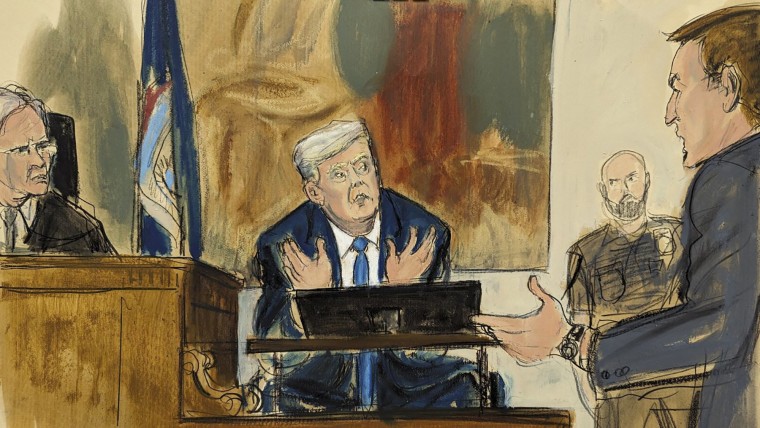Donald Trump’s long-awaited testimony in New York’s civil fraud case against him and the Trump Organization was a fiasco for the former president. He botched whatever slim chances he had of limiting the damage with the trial judge, compromised his chances on appeal, and signaled the bumpy road he will face when deciding whether to testify in his criminal cases.
Follow MSNBC's live blog coverage of Ivanka Trump's testimony here.
Trump had a steep hill to climb when he raised his right hand and was sworn in. Judge Arthur Engoron had already granted summary judgment on the first count in the case, finding that the wild disparities in the valuation of Trump properties like his Trump Tower apartment, his office building at 40 Wall Street, and his Mar-a-Lago club were fraudulent.
The former president tried two basic strategies: baiting the judge into overreactions and mistakes, and blaming others for his own actions.
Still, six counts remain; damages are yet to be calculated; and the remedies Engoron ordered in the partial summary judgment have been stayed by a New York appeals court judge pending a hearing. That shows that appellate judges were ready to take a hard look at Engoron’s rulings. Trump could have leveraged the prospect of Engoron being overruled on appeal for himself. Instead, he failed abysmally.

The former president tried two basic strategies: baiting the judge into overreactions and mistakes, and blaming others for his own actions. On the first, Trump almost succeeded in provoking Judge Engoron. At one point the judge threatened to draw a “negative inference” (a legal conclusion against Trump) from the former president’s repeated rambling and failure to directly answer questions. Engoron told Trump attorney Chris Kise, “I beseech you to control him if you can. If you can’t, I will. I will excuse him and draw every negative inference that I can.” That would have gone too far, as the legal requirements for such inferences were not met, and Engoron ultimately and wisely seems to have decided against that.
Trump’s second strategy — finger-pointing — also failed. Perhaps it would’ve worked if his lawyers were the only ones in court. But unfortunately for him, New York Attorney General Letitia James’ team repeatedly confronted Trump with his own approval of phony numbers and forced him to admit responsibility.
The state’s lawyers, for instance, forced Trump to admit that he was responsible for the preparation and presentation of the 2014 statement of financial condition, and that he would give his opinion on setting the value of his financial assets. Another damning admission came when Trump testified that “everybody” in the Trump Organization was responsible for detecting internal fraud. That’s an important admission because Trump inherently is a part of “everybody.”
New York’s lawyers also forced Trump to acknowledge that his financial statements contradicted the deed of development rights he signed with regard to his Mar-a-Lago property. The deed signed by Trump said “the Club and Trump intend to forever extinguish their right to develop or use the Property for any purpose other than club use.” But the financial statements valued it as a private residence, leading to an inflated number. When confronted, Trump’s defense was nonsensical: “‘intend’ doesn’t mean we will do it.”
Even Trump seemed to realize the damage he was doing.
Trump damaged himself not only with his substance but also with his style. He repeatedly evaded questions with various rants, including one in which he alleged that the judge “ruled against me before he knew anything about me. He called me a fraud, and he didn’t know anything about me ... The fraud is on the court; not on me.” The former president’s attitude killed what slight chances he had with Judge Engoron. His poor demeanor gives the judge another reason to find that the former president simply was not credible and that he was not honest.
All of that is not only fatal to the former president at the trial court level but also on appeal. Appellate courts typically defer to the conclusions of the fact-finder — the trial judge — based upon the firsthand observation. Should the judge rule as predicted, this aspect of his decision will be the most difficult to assail on the inevitable appeal of this case. Trump, moreover, created such a circus that the appellate court is likely to be sympathetic to the judge. They can’t allow this kind of behavior in the court system they oversee.
Even Trump seemed to realize the damage he was doing. After a lunch break, Trump’s demeanor changed from belligerent filibusters to frequently monosyllabic answers. That can only be read as a concession from the former president.
Perhaps most ominous of all for Trump is what all this means for his criminal cases. His lawyers may not have decided to call him as a witness in those cases anyhow, but given the long odds they are facing, they might have been tempted to gamble. No longer: The former president proved he is too uncontrollable to take the stand.
Donald Trump’s testimony not only devastated his position at trial and appeal of this important civil case, but it also compromised his criminal situation. That is the definition of a bad day at work.